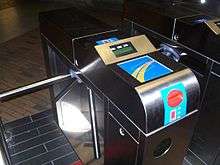OPUS card
 | |
| Location | Quebec, Canada |
|---|---|
| Launched | 2008-2009 |
| Currency | CAD |
| Credit expiry | None |
| Auto recharge | AMT TRAM Passes only. |
| Validity | |
| Website | carteopus.info |


OPUS is a rechargeable contactless stored value smart card using the Calypso Standard[1] and is used by most of the public transit operators in the province of Quebec, Canada.[2][3]
Fares
An advantage to the smart card compared to the previous system is the seamless integration with other transit networks of neighbouring cities. Another advantage relates to the speed at which users can access the system. As opposed to the magnetic stripe cards previously in use, the contactless smart card is more user-friendly in that not only will the card not risk becoming demagnetized and rendered useless, but it also does not require patrons to slide the card in a particular way — proximity to the contactless reader will suffice.
One card can contain up to four different kinds of fares. (An OPUS card can contain, for example, 1 STM monthly pass, 10 STL tickets, 6 CIT Laurentides tickets and 2 train tickets for AMT zone 5.) One transit fare simply overrides the other 3 when paying at any machine in a similar fashion to PayPass. The main goal behind the creation of this card is to reduce the amount of fare evasion that takes place in the province's transit systems.
The card is available at various points of sale where local transit fares are currently sold. Re-filling stations can be found at Montreal Metro stations, train stations, and Agence metropolitaine de transport bus terminals, as well as where local transit fares are sold.
Costs to the STM related to the project were approximately $138 million, compared to the original estimated cost of some $100 million. The project was originally supposed to be implemented in 2006.
Rollout phases
- Spring 2008 - Testing with employees of transit authorities and select groups of testers.
- Spring 2008 - Deployed for users of the RTL only.
- Fall 2008 - Deployed for students on all STM, STL and RTC as well as AMT TRAM users.
- Late Fall 2008 - Deployed for all regular fare users of all three transit authorities as well as AMT TRAM users.
- Spring 2009 - Start of deployment for users of CIT systems.
- Spring 2010 - End of deployment for users of CIT systems.
In preparation for this new step in Montreal's public transportation network, turnstiles that incorporate the reader and vending machines were installed in Metro stations; buses had previously been fitted with new fare boxes that incorporate the card reader, in order to ensure the uniformity of methods of payment across Montreal's transit network and that of its suburbs.
Participating transit authorities
| Transit Authority | Participant Since | Validation Method |
|---|---|---|
| Agence métropolitaine de transport[4] | Fall 2008 | ACS E-Validator |
| Société de transport de Montréal[5] | Fall 2008 | GFI Genfare Odyssey |
| Société de transport de Laval[6] | Fall 2008 | GFI Genfare Odyssey |
| Réseau de transport de Longueuil[7] | Fall 2008 | Proxibus VPE 415 Proximity Reader |
| Réseau de transport de la Capitale[8] | Fall 2008 | Proxibus VPE 415 Proximity Reader |
| Ville de Sainte-Julie | April 2009 | Proxibus VPE 415 Proximity Reader |
| Société de transport de Lévis[9] | Fall 2011 | Proxibus VPE 415 Proximity Reader |
See also
References
- ↑ "Map of the Calypso's Implementations" (PDF). Calypso Network Association. 2014-08-05. Retrieved 2014-09-22.
- ↑ "Smart transit cards come to Montreal, Quebec". CBC News. 2008-04-21. Retrieved 2008-07-22.
- ↑ "Opus's encore plays downtown". The Gazette (Montreal). 2008-07-15. Retrieved 2008-07-22.
- ↑ OPUS s'en vient bientôt
- ↑ Carte OPUS STM
- ↑ STL - Smart Card Information
- ↑ RTL - Carte a Puce
- ↑ RTC - Care a Puce
- ↑ RTC - Care a Puce